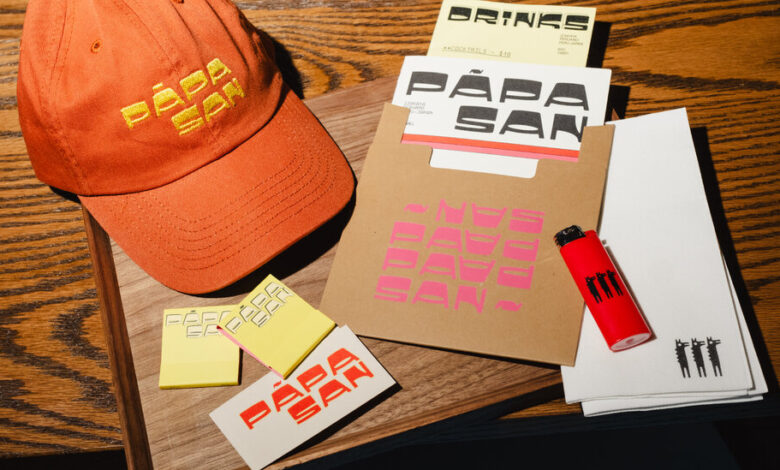Is the Restaurant Good? Or Is It Just the Ambience?

How many shades of pink and orange can you fit into a single restaurant? At Papa San in Midtown Manhattan, the limit may not exist.
A neon-orange sign bearing the Peruvian Japanese restaurant’s name — in chubby capital letters inspired by Japanese typography — flashes above the bar like a homing beacon over Hudson Yards. Customers sip pisco sours on branded pink coasters and visit a bathroom saturated in orange light. Employees wear burnt orange hats, descend a pink staircase and print checks over an orange table. Even an alcohol warning sign behind the bar includes the Papa San font and the word “warning” in a popping rosy hue.
The design is so pervasive and striking that you might forget this sunset-shaded expanse also serves food. Erik Ramirez, the chef and an owner of Papa San, is well aware of this.
“Everything is branding nowadays,” said Mr. Ramirez, who owns two other Peruvian restaurants in New York City. For diners, “I feel like the food element is kind of an after thought.”
A decade ago, the country’s most buzzed-about restaurants were largely defined by the ambition of the food and the credentials of the chef. Now, they’re all about atmosphere and appearance. For many diners who grew up in the visuals-obsessed Instagram era, a restaurant doesn’t need to have a particular aesthetic — it just needs to have a memorable one.
What might that look like? “Fun, stylish, and full of energy, with great drinks, good enough food and an atmosphere they can’t replicate at home,” said Anna Polonsky, the founder of the Brooklyn design studio Polonsky and Friends.
Sarah Hoski, who runs an Asheville dining Instagram account, said her followers are more interested in the holistic experience of a restaurant than just the food. “Very rarely do I now get the question of: What recommendations do you have because of the food?” she said. “It is more: What recommendations do you have because of the space or the vibe?”
Wholesale branding was once the domain of large restaurant groups with six- to seven-figure design budgets. Now, any restaurant can create a logo and custom merchandise thanks to online tools like Canva, said Jeff Chanchaleune, the chef and owner of the Lao noodle shop Bar Sen in Oklahoma City. He spent just $12,000 on branding for Bar Sen — about 5 percent of his total budget — and started selling hats and T-shirts before he had even finalized the restaurant’s menu.
“The way the space makes them feel,” he said, referring to customers, “might just make the food taste better.”
The cost of dining out is also steadily rising, said Hillary Dixler Canavan, the former restaurant editor of Eater. Customers want more than a meal when they’re at a restaurant — they want the theatrics. “Once you are spending a lot of money,” she said, you “expect the experience to rise with the bill.”
And as restaurants go ambitious with interior design and branding, many of them are betting that today’s customers prefer well-worn dishes with mass appeal. “They are serving basically what everyone else is serving: It is a steakhouse, it is a red sauce joint, it is a pizzeria,” Ms. Dixler Canavan said. “But look at the cool branding. The identity is wrapped up in what it looks like rather than what it is actually doing.”
Sharpies may be one of hundreds of pizzerias in Chicago. But it’s the only one with a flying saucer in the dining room, twinkling constellations on the ceiling and a three-eyed alien dog mascot.
Scott Koehl, an owner, said he felt free to experiment with design because he was serving something as widely available as pizza. His strategy worked: Sharpies has had strong, consistent business since opening in March, Mr. Koehl said. It has also gotten far more attention on social media than his other Chicago restaurant, Ada Street, which has no eye-catching logo, striking color palette or kitschy mascot. “I don’t think that restaurant could survive if it opened this year,” he added.
Mr. Koehl is already thinking about the custom apparel he will roll out — T-shirts, hats — in coming months. Before the pandemic, restaurants might ask her to create custom menus and coasters, said Ms. Polonsky, the designer. Now, she puts a limit to the amount of merchandise she will design. “Right after Covid everyone was asking us for baseball caps and sweatshirts, and I thought that was super wasteful,” she said. “How many baseball caps do people need?”
Restaurateurs don’t just want a dining room that looks nice — it has to be personal, too, she said, with details like customized wallpaper and first aid posters. Not long ago, many restaurants gravitated toward similar design approaches, like midcentury modernism, or neutral-hued minimalism, Ms. Polonsky said. “Now, in both branding and interiors, there is more and more a desire to create your own story,” she added.
As a young cook, Sam Yoo, who owns the New York restaurants Golden Hof, NY Kimchi and Golden Diner, believed that excellent food was the decisive factor in attracting customers.
“But once I flipped over as a business owner, I was like, ‘Oh, you know what? Food is only 40 to 50 percent,’” he said. “The rest of it is vibe and service.”
For Golden Hof and NY Kimchi, which both opened in Midtown in February, Mr. Yoo spent $200,000 total on atmospheric details, hiring a lighting designer, a music curator and an illustrator who designed art for the menus. “We are competing against the Major Food Groups and the Bad Romans,” he said.
Now, he has a new philosophy for success in the restaurant business. “Food, service and design are the holy trinity,” he said. “You need to have two out of three. You don’t need to have all three.”
Follow New York Times Cooking on Instagram, Facebook, YouTube, TikTok and Pinterest. Get regular updates from New York Times Cooking, with recipe suggestions, cooking tips and shopping advice.




